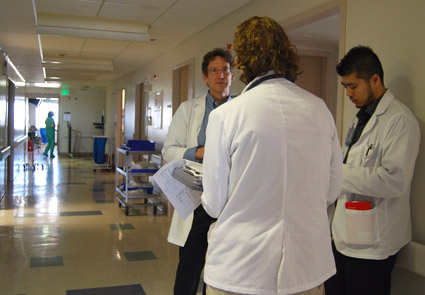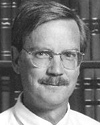
Richard Kravitz (left) on hospital rounds with medical students Kevin Trinh (right) and Jocelyn Tabor. A recent study co-authored by Kravitz shows that physician wage disparities could reduce access to primary care, especially for the nation's growing population of elderly patients.
Posted Nov. 10, 2010
A national study of physician wages conducted by UC Davis Health System has found that specialists are paid as much as 52 percent more than primary-care doctors, even though primary-care doctors see far more patients. As efforts to implement health-care reform evolve, the study is important because it quantifies wage disparities and explores the need for wage reform to help assure a strong primary-care workforce.
"Addressing the generalist-specialist income gap is critical to increasing access to cost-effective preventive care," said J. Paul Leigh, a professor in the UC Davis Center for Healthcare Policy and Research and lead author of the study, which is published in the Oct. 25 issue of the Archives of Internal Medicine. "There is a huge shortage of primary-care physicians, and in years to come many more of them will be needed to meet health-care reform goals."
The wage differences add up to millions of dollars over a lifetime, according to senior author Richard Kravitz, a professor of internal medicine and investigator with the Center for Healthcare Policy and Research. The result, he said, is a critical shortfall in the number of U.S. medical students entering generalist careers, in part because of the realization that peers in specialties such as radiology and dermatology will be making more money for less work.
"There is this sense that society simply doesn't value primary care," he said.
For the nationwide study, the investigators compared wages of more than 6,000 doctors practicing in 41 specialties in 60 communities. The data came from the 2004 to 2005 Community Tracking Study, a periodic evaluation of physician demographic, geographic and market trends.
 “Addressing the generalist-specialist income gap is critical to increasing access to cost-effective preventive care.”
“Addressing the generalist-specialist income gap is critical to increasing access to cost-effective preventive care.”
— J. Paul Leigh
Unlike previous studies analyzing income disparities, the research team compared hourly wages, factoring in the hours per day physicians reported working and excluding vacation time. The 2005 hourly wages for four broad specialty categories were as follows:
- Primary care, including pediatrics, geriatrics, family practice and internal medicine: $60.48 per hour.
- Internal medicine and pediatric subspecialties, including allergy and immunology, gastrointestinal, cardiovascular, rheumatology, pulmonary, critical care, medical oncology and neonatal: $84.85 per hour.
- Other medical specialties, including radiation oncology, physical medicine and rehabilitation, emergency medicine, psychiatry, neurology, ophthalmology and dermatology: $88.08 per hour.
- Surgery, including neurological, plastic, orthopaedic and obstetrics/gynecologic: $92.10 per hour.
The specialists with the highest wages were neurological surgeons, radiation and medical oncologists, dermatologists, orthopaedic surgeons and ophthalmologists. In general, physicians who earned the most money either performed surgery, deployed sophisticated technologies or administered expensive drugs in office settings. Lower-paid specialties primarily relied on talking with and examining patients.

Specialists with the highest hourly wages include neurological surgeons, radiation and medical oncologists, dermatologists, orthopaedic surgeons and ophthalmologists.
An over-reliance on highly specialized medicine results in skyrocketing costs as well as poorer overall health, as prevention and primary medical care are de-emphasized, according to Kravitz. The solution, he said, lies in reducing the wage disparities and redesigning the payment structure for care.
"Instead of rewarding the use of expensive and often risky procedures, greater emphasis should be placed on getting the basics right — immunizations, cancer screenings, chronic-disease management and recognition of the 'red flags' that signal the need for more intensive diagnostic study," said Kravitz.
The authors point out that a shortage of primary-care doctors will be especially worrisome as the baby-boom generation ages.
"Given the central role of generalists in caring for older patients with complex, chronic illnesses, these findings could predict future problems with meeting the medical needs of our growing population of elderly patients," said Leigh.
About the UC Davis Center for Healthcare Policy and Research
Investigators at the center conduct research on health-care access, delivery, costs, outcomes and policy to improve the practice of medicine, especially primary care.
Established as an interdisciplinary unit, the center includes more than 80 researchers who represent disciplines ranging from business management and epidemiology to psychiatry and pediatrics. For more information, visit http://www.ucdmc.ucdavis.edu/chsrpc/
Additional study outcomes revealed no significant differences in wages by race, indicating that medicine may have achieved wage parity for minorities. Wages for women, however, were $9 less per hour regardless of practice area, indicating that gender parity in physician wages has yet to be achieved.
In addition to Leigh and Kravitz, the other Center for Healthcare Policy and Research authors were Daniel Tancredi, assistant professor of pediatrics, and Anthony Jerant, professor of family and community medicine.
The study was funded in part by a grant to Leigh from the National Institute for Occupational Safety and Health and by grants to Tancredi and Kravitz from the UC Davis Office of the Vice Chancellor for Research.
A copy of "Physician Wages Across Specialties: Informing the Physician Reimbursement Debate" is available by contacting JAMA/Archives Media Relations at 312-464-5262 or mediarelations@jama-archives.org.